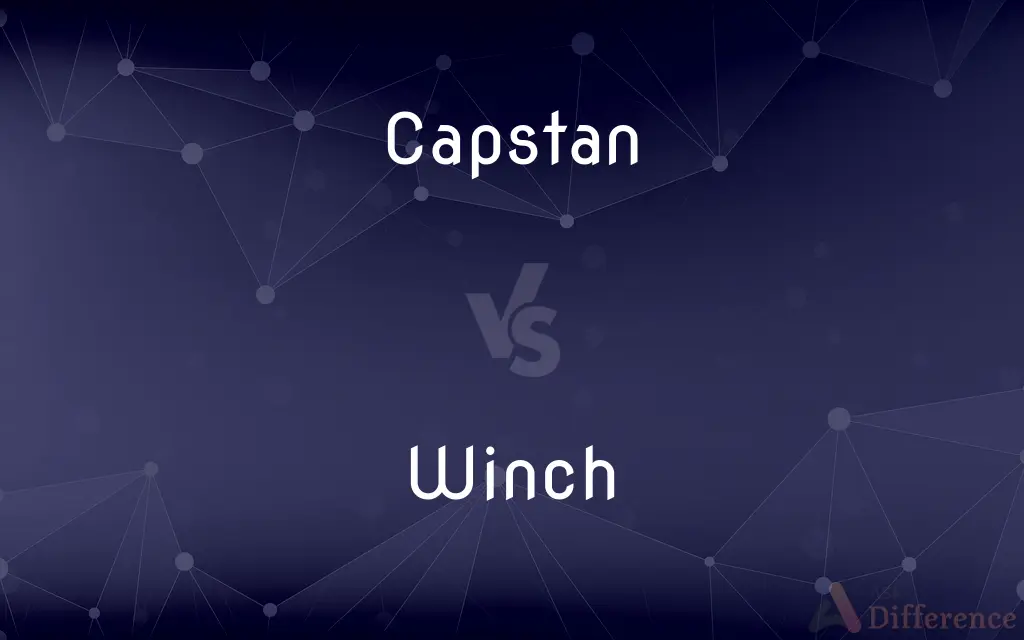Capstan vs. Winch — What's the Difference?
Edited by Tayyaba Rehman — By Fiza Rafique — Updated on February 23, 2024
A capstan is a vertical spindle used for moving heavy weights, primarily on ships, while a winch consists of a horizontal drum that winds up a cable or rope to pull or lift objects.

Difference Between Capstan and Winch
Table of Contents
ADVERTISEMENT
Key Differences
Capstans, with their vertical orientation, are designed to allow operators to apply force in a circular motion, making them ideal for maritime operations like hoisting sails or anchoring. Winches, on the other hand, feature a horizontal drum that efficiently winds cables or ropes, offering versatile applications in construction, off-road recovery, and marine contexts.
The design of a capstan, often found on ships, allows for continuous operation by applying force in a walking or circular manner around the device. This contrasts with winches, where the operator typically engages a motor or hand crank to coil the rope around the drum, making the process more mechanical and less reliant on continuous human effort.
Capstans are particularly suited for tasks that require the application of force from various angles, leveraging the vertical spindle to accommodate different pulling directions. Winches, with their fixed drum orientation, are more restricted in the direction of pull but excel in controlled lifting and pulling tasks due to their mechanical design and often motorized operation.
The mechanical advantage in a capstan comes from the diameter of the drum and the number of wraps of the rope, allowing for heavy loads to be moved with relatively less force. In winches, the mechanical advantage is also determined by the drum size and the gear ratio of the winch, which can amplify the pulling power significantly.
Both capstans and winches are essential tools in their respective fields, with capstans being indispensable in nautical operations for their ease of use and adaptability, and winches being crucial in various lifting and pulling applications across multiple industries due to their power and efficiency.
ADVERTISEMENT
Comparison Chart
Orientation
Vertical spindle
Horizontal drum
Primary Use
Maritime operations
Lifting and pulling in various industries
Operation Method
Continuous human effort in a circular motion
Motor or hand crank to wind the rope
Load Movement
Allows for force application from various angles
Direction of pull is more restricted
Mechanical Advantage
Dependent on drum diameter and rope wraps
Determined by drum size and gear ratio
Compare with Definitions
Capstan
A vertical spindle used on ships to move heavy weights.
The crew used the capstan to hoist the anchor aboard.
Winch
A device with a horizontal drum for winding rope.
They used a winch to pull the car out of the ditch.
Capstan
Operated by walking around to apply force.
Sailors circled the capstan, pulling the heavy ropes with ease.
Winch
Features motorized or manual operation.
The electric winch made light work of the heavy lifting.
Capstan
Suited for maritime applications.
The old ship was equipped with a traditional capstan for its sails.
Winch
Efficient in controlled lifting and pulling.
With the winch, they could easily maneuver the heavy beams.
Capstan
Allows force application from multiple directions.
The capstan's design made it versatile for various nautical tasks.
Winch
Common in construction and recovery operations.
The construction site was equipped with heavy-duty winches.
Capstan
Relies on human effort and technique.
Their coordinated efforts around the capstan exemplified teamwork.
Winch
Offers significant mechanical advantage.
The winch's gear ratio amplified their pulling power.
Capstan
(nautical) A vertical cylindrical machine that revolves on a spindle, used to apply force to ropes, cables, etc. It is typically surmounted by a drumhead with sockets for levers used to turn it.
Winch
A hauling or lifting device consisting of a rope or chain winding round a horizontal rotating drum, turned typically by a crank or by motor.
Capstan
A broad revolving cylinder with a vertical axis used for winding a rope or cable, powered by a motor or pushed round by levers.
Winch
An axle or drum turned by a crank with a handle, or by power, for raising weights, as from the hold of a ship, from mines, etc.; a windlass.
Capstan
(Nautical) An apparatus used for hoisting, consisting of a vertical, manually or mechanically rotated cylinder around which the cable to be pulled runs.
Winch
A winch is a mechanical device that is used to pull in (wind up) or let out (wind out) or otherwise adjust the tension of a rope or wire rope (also called "cable" or "wire cable"). In its simplest form, it consists of a spool (or drum) attached to a hand crank.
Capstan
A windlass rotated in a horizontal plane around a vertical axis; used on ships for weighing anchor or raising heavy sails
Winch
A machine consisting of a drum on an axle, a friction brake or ratchet and pawl, and a crank handle or prime mover (often an electric or hydraulic motor), with or without gearing, to give increased mechanical advantage when hauling on a rope or cable.
Winch
An instrument with which to turn or strain something forcibly.
Winch
Lifting device consisting of a horizontal cylinder turned by a crank on which a cable or rope winds
Common Curiosities
What is the main difference between a capstan and a winch?
The main difference lies in their orientation and application: capstans have a vertical spindle for maritime use, while winches have a horizontal drum for various lifting and pulling tasks.
How does the design of a capstan facilitate its use on ships?
The vertical design allows operators to apply force in a walking motion around the spindle, suitable for the spatial constraints and tasks on ships.
Can a capstan be used for tasks other than maritime operations?
While primarily designed for maritime use, capstans can be adapted for other tasks that require vertical pulling.
Can a winch be used to lift weights vertically?
Yes, winches can lift weights vertically, provided they are securely anchored and the load is properly attached.
What role does the gear ratio play in a winch's operation?
The gear ratio in a winch amplifies the force applied, allowing for heavier loads to be lifted with less input force.
How do operators control the load movement with a capstan?
Operators control load movement by varying the force and direction they apply as they walk around the capstan.
Are there safety concerns associated with using capstans and winches?
Yes, safety is crucial, as improper use can lead to accidents. Proper training and adherence to safety protocols are essential.
Can the direction of pull in a winch be adjusted?
The direction of pull in a winch is generally fixed due to its horizontal drum orientation, but the device itself can be positioned as needed.
Are winches always motorized?
No, winches can be either motorized or manually operated, depending on the specific application and requirements.
Are capstans suitable for continuous operation?
Yes, capstans are designed for continuous operation, allowing for sustained effort in a circular motion.
Is manual effort required to operate a capstan?
Yes, capstans typically require manual effort, with operators walking around the spindle to apply force.
How does the winch's drum contribute to its efficiency?
The winch's drum efficiently winds the rope or cable, providing controlled lifting and pulling with minimal slippage.
What is the key to the mechanical advantage in capstans and winches?
The mechanical advantage in capstans and winches is determined by the diameter of their drums and, in winches, additionally by the gear ratio.
Can both capstans and winches be used in the same setting?
While they serve different purposes, both devices can be found in maritime settings, with each performing tasks suited to their design.
What factors should be considered when choosing between a capstan and a winch?
Factors include the specific task requirements, load weight, direction of pull needed, and available space for operation.
Share Your Discovery

Previous Comparison
Community vs. Culture
Next Comparison
Hiatus vs. SpellAuthor Spotlight
Written by
Fiza RafiqueFiza Rafique is a skilled content writer at AskDifference.com, where she meticulously refines and enhances written pieces. Drawing from her vast editorial expertise, Fiza ensures clarity, accuracy, and precision in every article. Passionate about language, she continually seeks to elevate the quality of content for readers worldwide.
Edited by
Tayyaba RehmanTayyaba Rehman is a distinguished writer, currently serving as a primary contributor to askdifference.com. As a researcher in semantics and etymology, Tayyaba's passion for the complexity of languages and their distinctions has found a perfect home on the platform. Tayyaba delves into the intricacies of language, distinguishing between commonly confused words and phrases, thereby providing clarity for readers worldwide.














































